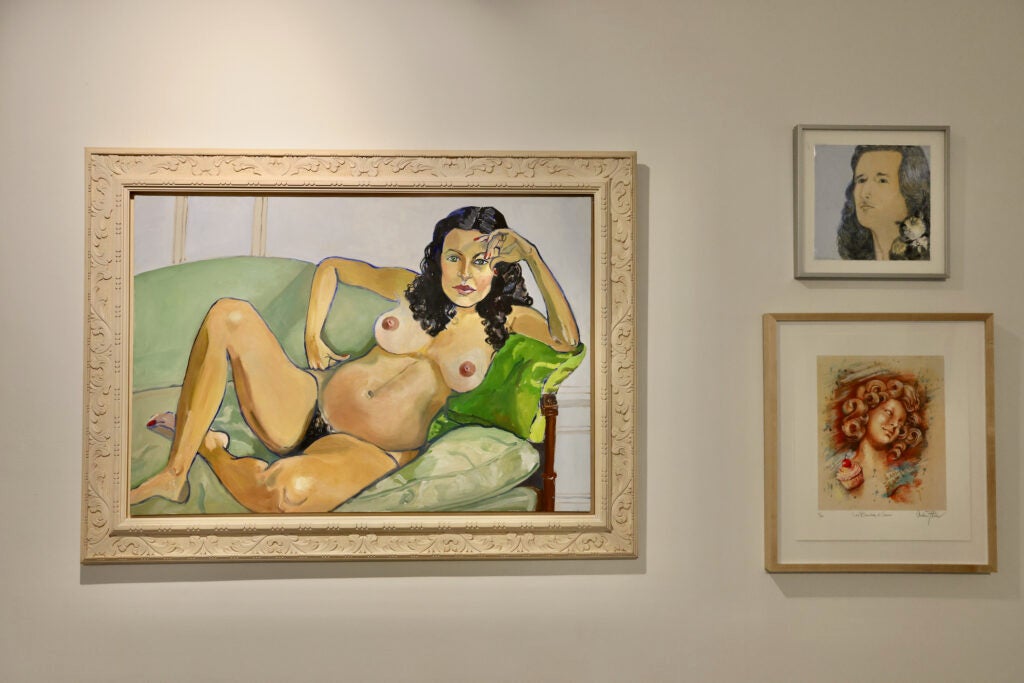The original Focus show was a collective effort with women artists forming various committees to raise money, coordinate galleries, plan over 150 exhibitions and events, reach out 83 exhibiting artists, and advertise the event: the collective produced a radio spot that asked, “Can you name 10 women artists?”
Two participating artists were Ree Morton and Cynthia Carlson, who had already rejected a similar invitation in New York and regretted it.
“We were both invited to be in the show and in the A.I.R. Gallery, and we both said no, which was a mistake,” said Carlson, who at the time was teaching at the Philadelphia College of Art (now the University of the Arts). “We didn’t want to be known as a woman artist. We just wanted to be known as an artist.”

“At that point, in terms of feminism or women artists, I wasn’t the sharpest tack in the box,” said Carlson, who became a central figure in the Pattern and Decoration art movement of the 70s and 80s.
“My students in Philadelphia were much more: ‘Come on, Professor Carlson. Let’s get rolling with this!’ I was a little slow on the uptake, but eventually, I caught up and understood the importance of the whole movement towards women taking initiative and showing.”
Carlson sent a piece to the original Focus exhibition in 1974, but can’t remember what it was. Records show it was “Untitled” (1972), acrylic on wood, but no image exists.
“My memory has never been at the top of the mark. That’s a reason that I don’t like to lie,” said Carlson, 82. “You have to remember your lies.”
Carlson did not know which piece was in the current (re)Focus until a reporter told her that the organizers borrowed her 1975 piece “Sixish” from the Woodmere Museum. The piece was made by piping thick wads of acrylic paint onto a board with cake-decorating equipment.
“I always valued humor in my work, but that one is a good one,” she said. “Not quite a knee-slapper, exactly, but it has a lot of humor in its seriousness.”
Carlson has been averse to associating her art with gender or social issues, and was not the only one who hesitated to join group shows of women in the early 1970s. Of the 83 artists approached to show their work, 82 accepted. It’s not clear who was the holdout. In one of the essays for the 50th-anniversary catalogue, art historian Judith Stein thinks it might have been Georgia O’Keefe. In another essay, curator Ruth Fine believes it was Helen Frankenthaler.
The original Focus was not without controversy. Burko remembers being threatened with a lawsuit by a local artist who was upset that he could not get his work shown because Focus had booked up all available galleries for two months.
At the Philadelphia Civic Center, the main venue of Focus, the director demanded that one artist be removed from the show: Judith Bernstein, who submitted a large-scale abstract drawing of a penis.
It was either “Bernstein comes down, or the whole show comes down.” The exhibition relented, but in retaliation, printed and distributed buttons that read “Where’s Bernstein?”
It proved to be a turning point in Bernstein’s career.
“A few years ago, we were both on a panel together, and she was so excited to see me. We hadn’t seen each other in a long time,” Brodsky said. “She said, ‘That was the start of my recognition.’ That gave her the visibility she hadn’t had before. She always says that was really the start of her successes as an artist.”
Bernstein has a piece in a similar phallic vein in the new (re)Focus show, which will likely not attract the same controversy. Of the 82 original exhibiting women, 78 are represented in the new show. Burko and Brodsky could not track down four artists.
“There is a thing that happens not just in the art world, but also in other sectors of civilization: women who are really famous when they’re alive somehow disappear, forgotten,” Brodsky said.
One of the reasons information is sparse about the original Focus exhibition is it never had a catalogue. The organizers raised about $95,000, enough to stage the events but not enough to produce a published document when it was all over. The archives of the project are held at the Philadelphia Museum of Art.
This time, the (re)Focus reboot has a catalogue that identifies all participating artists, the pieces they exhibited originally and the ones showing now. The exhibition was put together with curators Gabrielle Lavin Suzenski, at the Galleries at Moore, and independent curator Marsha Moss.
Burko hopes it will serve as a record of what women have been doing for decades to elevate themselves collectively.
She points to the recent bestselling book, “The Story of Art Without Men,” by Katy Hessel, an art writer who had a similar revelation about women and art 40 years after Burke did.
“In 2015 she discovered there were not many women in all the art fairs she was going to.” Burko said. “Hello! We discovered it way back in 1974.”
“(re)Focus: Then and Now” opens Saturday, Jan 27, at the Galleries at Moore and runs until March 16. Associated exhibitions run at various times until the fall.